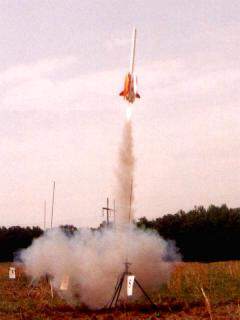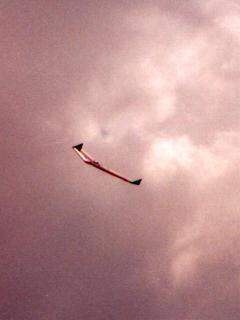| | | |
| | |
| The model airplane company named "Robart", best known for R/C airplane accessories such as retractable landing gear, has come out with a series of styrofoam "toy" gliders, which they call their "Top Gun Gliders". The three out so far are the F-16, F-117, and "UFO". The UFO is sort of like a blended-body hybrid of a flattened lifting body with sort-of regular outer wing, except it has an "alien" style of design appearance to it. The F-16 was a bit too big and the F-117 a bit too tricky to do the rudder-only piggyback conversion. I chose to use the UFO design to convert to rudder-only R/C, adding a removable fin/rudder to the top. Installing the radio gear itself was pretty easy, cut a hole just the size of the servo into the top of the "body" and jammed the servo into place, with a hole running down to run the servo wiring. The servos used for both gliders were old Cannon super-micro servos, nowadays there are a nubmer of 1/2 oz or less servos available cheaply. The receiver (Hitec 555 micro) is mounted into the belly, into a rectangular hole cut into the foam. Same for the 50 mAh nicad battery pack. Glide weight of about 6 ounces. EACH. Why each? Too tricky to work up a good way to piggyback a glider with this size and mass, and not as much fun either, so two were converted to fly on opposite sides of a piggyback booster. One painted orange so the pilots could tell which was which. The booster is 56" of BT-70 (Totally Tubular), ejecting in the middle, plus a BMS BT-70 nose cone. First flight was on an F22J-5 reload. Unfortunately it turned out to be too long of a delay and ejected late, and into the sun. So, the flight was successful but not very long. And right after that flight Gene Hornbuckle, who was the pilot for one of the gliders, had to leave (Gene is a very experienced R/C sailplane flier as well as rocketeer). His replacement was SEP program manager Greg Warren, who had never flown R/C before. Well, this is also part of what this is about, something for newcomers to try to fly. But it was a bit windy so there was potential for an unpiloted or badly piloted model to glide far far off, fortunately Greg had done R/C cars before so he had experience with the "coming at you" steering reversal problem (if the model is coming your way and you want it to go to your right you have to steer it left). The F25 took it to about 600 feet, ejecting at about 500 feet. The nose-down dive of 100 feet meant the gliders had a lot of speed when they pulled out at ejection, so they both peeled away in opposite directions and after a couple of stalls, settled into glides. Greg had no problem at all controlling his, and for most of the flight we flew in formation, or about as much in formation as rudder-only allows. Greg landed within 100 feet of the launch site. Flying time...unknown, but probably along the lines of 90 seconds. So, the model(s) worked out just great, as hoped. The "Robart fleet" will be flown at NSL and NARAM. If someone is interested in building their own, let me know for more details. Another exciting thing about this Robart series is that later in the year when they come out with 3 more foam gliders, one is supposed to be a shuttle orbiter. That orbiter will likely be similar in size to the 1/60 piggyback R/C orbiter I fly, which has a span of 18". All these Robart foam gliders have a span in the 16.5 to 18" range. Pictures at right courtesy of Ronny and Greg Tipps of Waverly, Tennessee. Unfortunately, Robart does not list these gliders o n their web page. If your local hobby shop does not carry them, contact Robart. Phone:630-584-7616 Email: robart@robart.com Robart Manufacturing, Inc., P.O.Box 1247, St Charles, IL 60174 |   |
| Here's a close-up pic of the "UFO" Robart glider on an earlier BT-60 sized carrier rocket (BT-60 was burned badly by the "afterburn" after ejection, BT-70 is big enough not to suffer as much). Visible in the center top of the UFO glider is a Cannon super-micro servo, jammed into a rectangular hole cut into the styrofoam. The dark line just left and trailing behind it is the 1/32" music wire pushrod that attaches to a control horn on the rudder. The red fin/rudder is made of balsa, and attached in a removable fashion for transport purposes. The UFO is 16.5" span and about 18" long. The other glider in this photo was the F-117. I had hoped it would be possible to do two different gliders but the whole model pitched to one side during boost, and would have crashed if not for a slow roll. So, only two identical gliders should be used.
Photo at Right courtesy of Greg Warren of the SEP program.
| |
| A different kind of model, a Zagi flying wing. The Zagi is a 48" span R/C slope combat glider. This one was convertedto boost on rocket power, using F13 and G12 reloads. It is quite aerobatic, thanks to its use of full-span elevons. To find out more about the Zagi flying wing, go to the Trick R/C (Zagi) home page Photo courtesy of Ronny and Greg Tipps of Waverly, Tennessee.
|
|
| | | |
